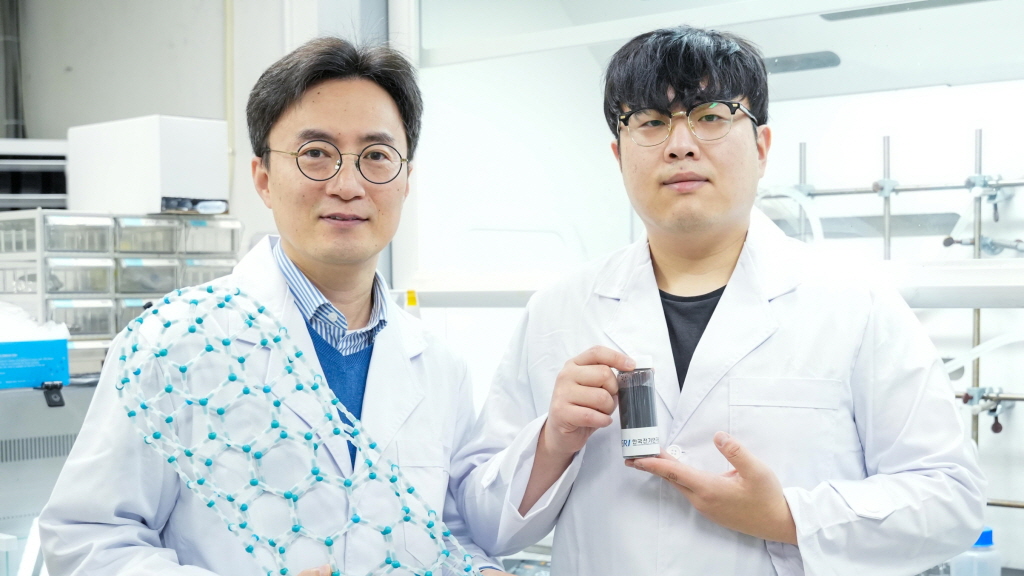한국전기연구원(KERI) 나노융합연구센터 한중탁 박사와 이도근 학생연구원이 리튬이온전지 음극재의 고용량·고안정성을 확보하는 ‘실리콘-질소도핑 카본 복합음극재’ 제조 기술을 개발해 향후 실리콘의 한계를 극복할 수 있을 것을 기대가 모아진다.

▲질소도핑 단일벽 탄소나노튜브 모형을 들고 있는 KERI 한중탁 박사(왼쪽)와 복합음극재를 들고 있는 KERI 이도근 학생연구원
전기연구원, ‘실리콘-질소도핑 카본 복합음극재’ 제조
질소를 도핑한 단일벽 탄소나노튜브가 이차전지 음극재의 성능을 높이는 기술이 개발돼 향후 실리콘의 한계를 극복할 수 있을 것으로 기대가 모아진다.
한국전기연구원(KERI)은 나노융합연구센터 한중탁 박사와 이도근 학생연구원이 리튬이온전지 음극재의 고용량·고안정성을 확보하는 ‘실리콘-질소도핑 카본 복합음극재’ 제조 기술을 개발했다고 23일 밝혔다.
실리콘은 리튬이온전지의 기존 음극(-) 소재인 흑연보다 에너지 밀도가 약 10배 이상 높지만, 지속적인 충·방전 시 부피가 3∼4배 팽창한다는 단점이 있다.
또한 실리콘 입자가 쉽게 부서져 전지의 성능을 감소시키는 문제도 있어 단독으로 음극재에 활용할 수 없었고, 흑연에 실리콘을 일부 첨가하여 서로의 장단점을 보완하는 기술이 개발되고 있다.
현재 많은 연구진이 실리콘의 문제를 미래 신소재인 탄소나노소재로 해결해서 실리콘의 첨가량을 늘리기 위한 노력을 기울이고 있다.
그중 KERI의 방안은 ‘질소를 도핑(doping)한 단일벽 탄소나노튜브’와 ‘그래핀(Graphene)’으로 실리콘의 한계를 극복한 것이다.
탄소나노튜브는 다중벽과 단일벽으로 나뉘는데, 벽이 1개인 단일벽이 가늘고 투명해 물성과 전기전도성이 훨씬 좋다.
질소는 리튬이온과 친화도가 높고, 전기화학적으로 안정된 원소다. 이들을 실리콘 복합음극재에 적용할 경우, 이론적으로는 아주 좋은 궁합이지만, 탄소나노튜브는 서로 뭉치려는 성질이 있어 상용화를 위해서는 이를 분산하는 기술이 반드시 필요했다.
특히 단일벽 탄소나노튜브는 지름이 1∼2나노미터(nm)에 불과하기 때문에 다중벽보다 분산이 훨씬 더 어렵다.
이에 KERI는 10여 년 이상 축적해 온 나노융합 기술을 바탕으로, 밀가루를 반죽하는 방식과 유사하게 단일벽 탄소나노튜브를 분산하는 획기적인 기술을 세계 최초로 개발했다.
그리고 해당 기술을 통해 리튬이온을 좋아하는 질소를 탄소 사이사이에 효과적으로 넣는 데(도핑)까지도 성공했다.
이렇게 개발된 ‘질소도핑 단일벽 탄소나노튜브’를 리튬이온전지의 음극재에 적용하면 리튬이온이 실리콘으로 이동하는 속도를 높여 충전 속도를 높이고 충·방전 싸이클 안정성을 향상시키는 효과가 있다.
이에 더해 한중탁 박사팀은 음극재 외부를 우수한 전기 전도성 및 기계적 강도를 지닌 그물망 구조의 그래핀으로 감싸 실리콘의 부피팽창을 억제하는 안정성도 확보했다.
연구팀은 리튬이온전지 충·방전 100회 실험을 통해 성과의 효과도 확인했다. 그 결과 기존 실리콘 복합음극재가 적용된 리튬이온전지는 30% 정도만 전지 성능이 남은 반면, KERI의 ‘실리콘-질소도핑 카본 복합음극재’가 적용된 전지는 82% 이상 성능을 유지했다.
KERI 한중탁 박사는 “우리의 탄소나노소재 복합음극재는 실리콘의 단점을 메우고, 고용량이 장시간 안정적으로 유지되는 장점이 있다”며 “전지 전극의 전도성과 성능을 높이기 위해 기존에 첨가되던 카본블랙과 같은 도전재를 넣지 않아도 될 수준”이라고 전했다.
연구팀은 이번 기술이 리튬 확산속도가 중요한 ‘전고체전지’ 음극에도 활용이 가능할 것으로 보고 있다. 해당 연구결과는 우수성을 인정받아 재료공학 분야 국제 저명 학술지인 ‘Advanced Functional Materials’에 최근 논문이 게재됐다. 학술지의 영향력을 평가하는 ‘JCR Impact Factor’는 19로, 해당 분야 상위 3.7%에 속한다.
KERI는 개발한 복합음극재가 적용된 리튬이온전지 풀 셀(Full-cell)에 대한 평가를 마무리하고, 특허출원까지 완료했다. 이를 기반으로 관련 기술이 고용량 리튬이온전지가 필요한 기업들의 많은 관심을 받을 것으로 보고, 수요 기업을 발굴하여 기술이전을 추진한다는 계획이다.
한편 KERI는 과학기술정보통신부 국가과학기술연구회 산하 정부출연연구기관이다.
